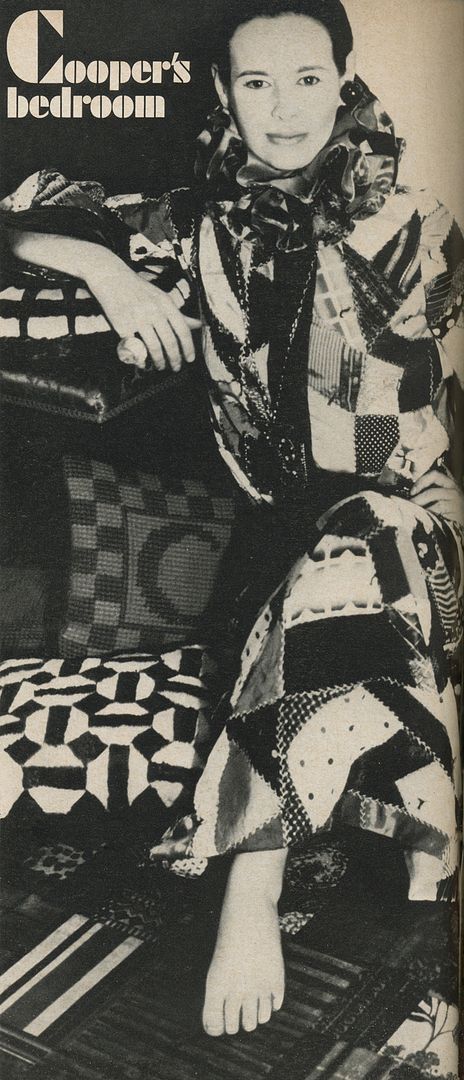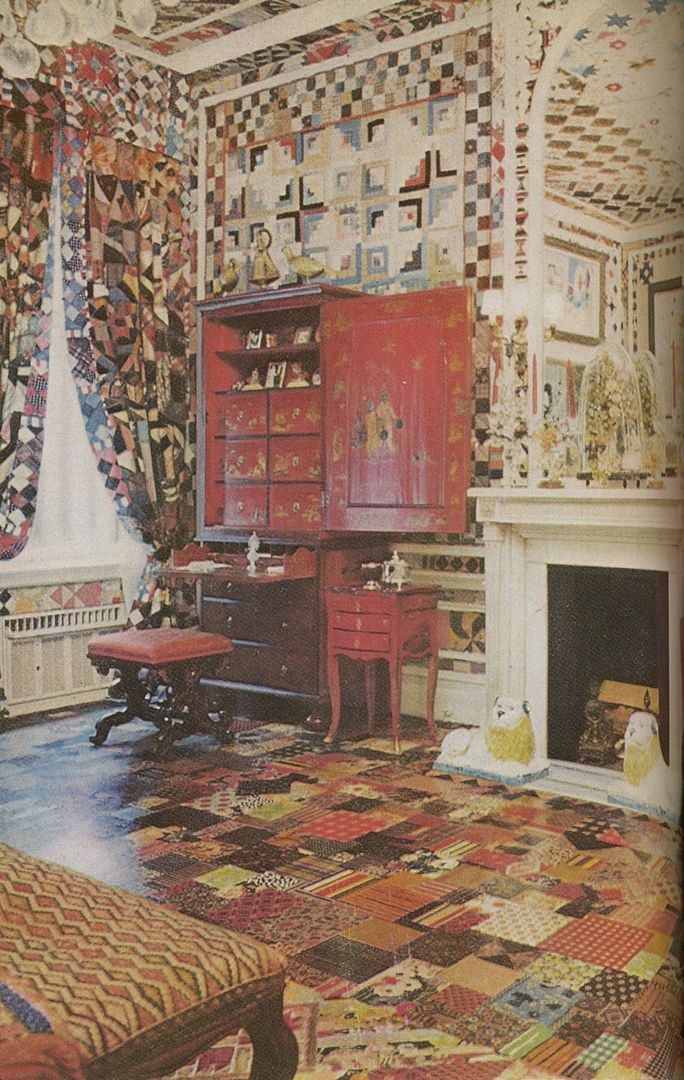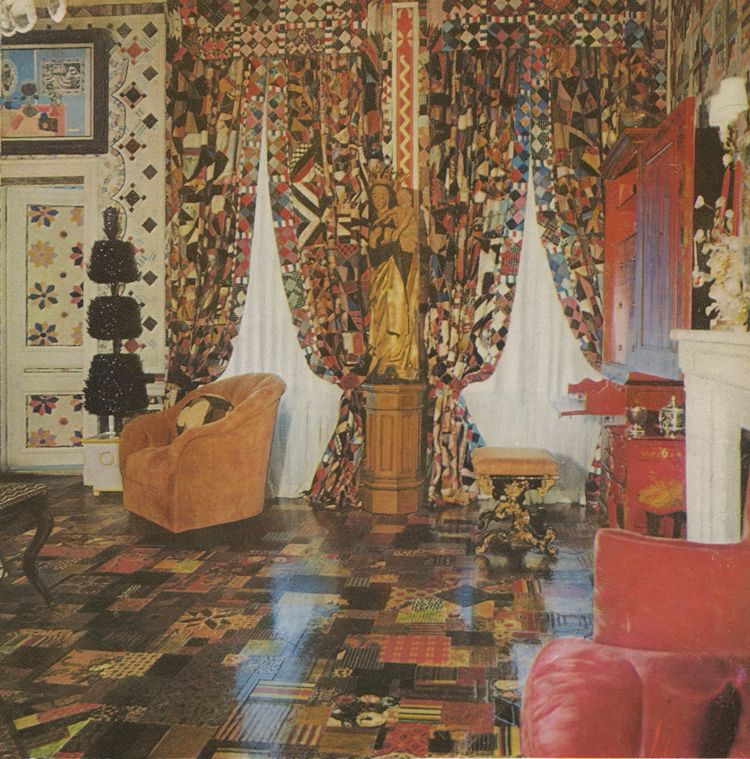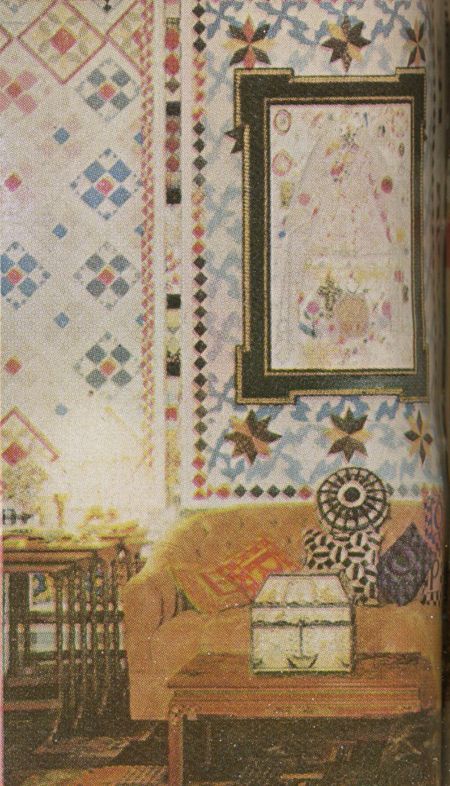
The floor glints and gleams like terazzo... The walls and ceiling vibrate like the candlelit, mosaic-covered chapels of Ravenna's Romanesque churches, and its furnishings and fixtures are a curious conglomeration of diverse elements. This is the bedroom of Mrs Wyatt Emory Cooper - Gloria Vanderbilt, the painter. "Isn't it extraordinary," she said. "how something as simple as quilts from America suddenly begins to relate to Russia and the East, to become exotic and mysterious when used in a certain way."
For the mosaic effect of the walls and ceiling is the result of using two dozen, beautifully figured, handmade, American patchwork quilts as a kind of tapestry; and the floor is not marble at all, but a great collage of patterned patches of cloth in a highly varnished, carefully worked out arrangement.

The enamel-white mantlepiece displaying one of Mrs Cooper's favourite pieces - a Victorian wedding memento with bride and groom figures in a garden of flowers and trees made of tiny shells. The English, Chinese-style desk, to the left, and Queen Anne chest, which conceals a television set, are old family heirlooms. In the foreground, a petit-point covered, 17th-century French bench and Elizabethan jewellery chest embroidered with seed pearls.
The room is essentially an out-growth of Mrs Cooper's work as a painter. "I realised it was like doing one of my collages. Each touch we added suggested - almost demanded - what should be done next."
The secret of its success - like the secret of her collages, many of which hang against the room's quilted walls - is in its contrasts and unexpected use of materials. There is gingham fabric next to a Coromandel screen, an Elizabethan jewellery chest atop an English, Chinese-style red-lacquer table, a modern suede couch beside a 14th-century statue of the Virgin, a 17th-century French bench beside a brass bedstead - layer upon layer, texture upon texture - all as imaginatively juxtaposed as elements in Wallace Steven's metaphors.

The curtains, left unlined to retain their translucent, stained-glass effect.

Close-up of the patchwork floor covering of highly varnished, square and rectangular pieces of brightly coloured fabric.
The Coopers began by quilting the areas inside the moulding-bordered wall panels of the room. Later, they covered all the walls leaving only the mouldings which they had painted a high-gloss, enamel white. Then they gave the ceiling the same quilted treatment, enamelling the ceiling's frieze-work.
Selecting the right floor covering presented the most difficult problem. "No rugs seemed to work, and at first I thought the only solution was to paint the floors white as we did in our country house." One day she noticed some scraps of cloth on the floor. " That was the solution. So we had it put down and covered with a clear varnish."

The cupboard-lined foyer to the bedroom, covered with red and white gingham fabric. Above the sofa, one of Mrs Cooper's collages of the Virgin and Child. The ivory figure of the virgin and Child is French 14th-century.

A collage of a cavalier by Mrs Cooper.
Once the walls, ceiling and floor were completed, the coopers tackled the furnishings. "I thought of the brass pieces and the glass-topped tables to the room would shine through. We bough those pieces and the suede sofa and chair at Bloomingdale's." Most of the other pieces were taken from the Cooper's collections of furniture and decorations. "We found ourselves taking things from all over the house. Somehow there seemed to be places for all the things we loved."
Mrs Cooper... feels collage is a form that many people will find enjoyable whether using it artistically or decoratively. "It was marvellous how taking things we loved... useful things, impractical things, familiar and rare, old and new, all sorts of things that seemed unrelated became terribly relaed in the way we used them."

Photos by Horst for Vogue UK, June 1970.